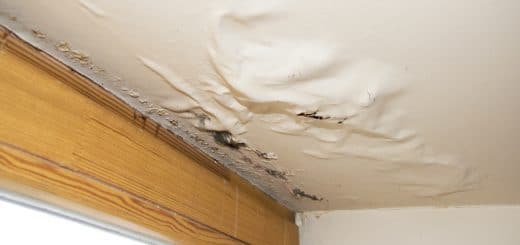How to Effectively Leak Proof your Home to Prevent Water Damage

You may not be able to open a gigantic umbrella over your house, but you can still find effective waterproofingWaterproofing is the application of materials or coatings de... More solutions for your home.
Keeping water out of your home is quite a tricky business – plumbing problems often cause excessive moisture, tiny rain drops easily find their way in through small cracks in the foundation, the roof, or the walls of your house, etc. And though a few drops don’t seem to cause any harm, the excess water will quickly penetrate the porousPorous describes a material that contains small openings or ... More materials in your home, resulting in severe structural damage, moldMold is a type of fungus that grows in damp or humid conditi... More growth, and other humidityHumidity is the amount of moisture or water vapor present in... More problems. Therefore, to prevent water damage to your property, you need to waterproof your home – take proper care of any house leaks and plumbing issues you have, seal gaps around doors and windows, add proper insulationInsulation is a material used in buildings to reduce the tra... More, etc. The best part is that you’ll not only prevent water from damaging your property, but will also cut down on your energy bills in the winter.
All you need to do is effectively leak proof your home.
Waterproof the Roof
The excellent condition of your roof is the main prerequisite for a waterproof home. To make sure that your shelter will withstand even the most adverse weather conditions without letting a single drop of water inside, you are recommended to:
Inspect and Repair the Roof
Have your roof carefully inspected during the first months of autumn to have enough time for any necessary repairRepair is the act of fixing or restoring damaged property, m... More work before the snow falls. Replace any broken tiles and have loose or misplaced ones properly fixed to avoid roof leaks and severe water damage.
Inspect and Repair the Chimney
If the flashing (the sheet metal that keeps the intersection between the chimney and roof watertight) is cracked, loose, or missing, water will easily leak around the chimney and get into your home, causing a variety of problems. So, invest in quality flashing and don’t forget to put a cap over your chimney (unless it already has one).
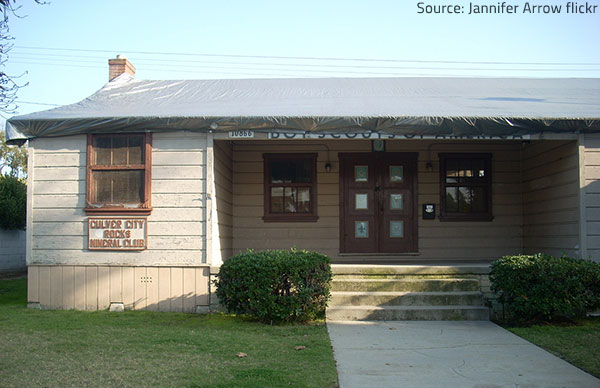
Covering the roof with tarpaulin may be a bit excessive – read on to learn of some more practical ways to waterproof the roof of your home.
Add Attic Insulation
Proper insulationInsulation is a material used in buildings to reduce the tra... More will help maintain both the temperature and the moisture level in your surroundings at an optimal level, considerably increasing the energy efficiency of your home and keeping it waterproof.
Clean the Gutters
Leaves and debris can block the drains and the downspout, preventing water from draining from the roof. To avoid this problem, you need to clean the eaves, troughs, and the drainpipes once in a while – remove dead leaves and branches from the shingles, scoop debris from the gutters, wash small debris down the downspout with a garden hose, and make provisions for the water to drain away from the house walls.
Have in mind that water pooling in the gutters means that the downspout is clogged and urgent measures are required in order to prevent water from spilling over (as it has nowhere to go) and running down the wall, causing excessive dampness and, possibly, internal leaks.
Needless to say, you should regularly inspect the gutters and the drainpipes, and timely replace damaged or rusty ones.
Once you have eliminated the possibility of a leaky roof, you need to turn your attention to other potential ways in which water can infiltrate your home.
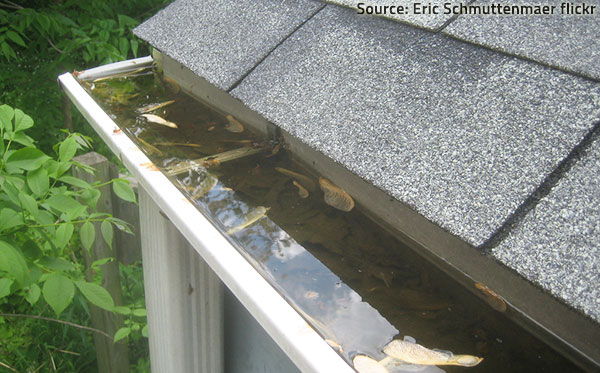
Keeping the gutters free of debris is essential for preventing water damage to your home.
Waterproof the Foundations
As already mentioned, even the smallest cracks in your foundation walls can let water inside. So, in order to avoid basement floodingFlooding is the overflow or accumulation of water in areas t... More and water damage to your property, you need to effectively waterproof the foundations:
- RepairRepair is the act of fixing or restoring damaged property, m... More cracks – Inspect the foundation walls for cracks and address them before excess water from torrential rains or heavy snow has had the time to get inside and cause structural damage. Small cracks can be sealed with caulk designed to repairRepair is the act of fixing or restoring damaged property, m... More masonryMasonry is the craft or construction of structures using mat... More. Larger gaps should be fixed with the help of hydraulic cement – an excellent leak-proofing material that will effectively keep water away;
- Direct water away from the foundations – Make sure the grading around your house slopes away from the foundations (adding several inches of crushed stone or topsoil around the foundation once a year will do the trick). This way, water will drain away from your house, causing no catch basins may also help keep water off the foundations – you can dig a U-shaped trench or a cylindrical well in the lowest part of your property to collect excess water. Line the walls of the basin with fabric, fill it with gravel, and keep it free of debris.
Last but not least, make sure that all the openings for pipes, wires, and duct work in the roof area and underneath your home are well sealed. Also, check for gaps where pipes and air conditioning ducts pass through the walls and take adequate measures to fix the leaks (if any).
Sealing your home, however, will not be efficient enough unless you seal the doors and windows, too.
Leak-Proof Doors and Windows
Snow and rain can easily get inside through badly-fitting doors or windows, especially when strong wind is blowing against the side of your home. To waterproof doors and windows you are advised to:
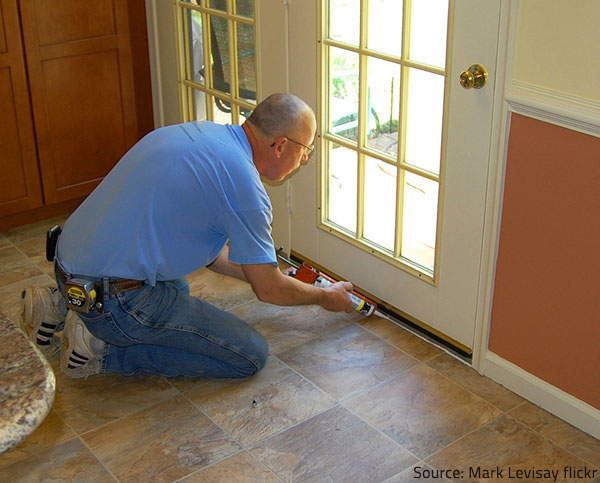
You need to pay meticulous attention to the details if you want to effectively leak-proof your home.
- Apply caulk on both sides of the window to prevent water from seeping inside;
- Use weather-stripping to seal doors and windows that don’t close tightly;
- Fit a keyhole cover in front of door locks to keep rainwater and snow outside;
- Install storm windows to provide an additional layer of protection against rain and snow.
Sealing doors and windows will not only help keep water away from your home, but it will also considerably improve the thermal efficiency of your property.
By following the above tips, you’ll be able to effectively weatherproof your home, thus reducing the risk of water damage problems and lowering your utility bills. Home water damage, however, may also be caused by leaky pipes and fixtures. So, in order to completely eliminate the possibility of water damage to your property you need to prevent plumbing problems as well.
Take Care of the Pipes
As the old adage goes, “An ounce of preventionPrevention refers to actions taken to reduce the likelihood ... More is worth a pound of cure”. So, inspect the plumbing system in your home on a regular basis and maintain it in a good condition to avoid problems. Should the pipes leak and cause water damage, the restorationRestoration is the process of returning a property to its pr... More works will cost you a lot of headaches, time, and money, so take all the necessary precautions to prevent it from happening – replace damaged or rusty pipes and valves as soon as you notice the problem and protect them properly during the cold months:
- Disconnect the downspouts from the sewer system whenever possible to forestall back-up of waste water. Also, don’t forget to disconnect the garden hose and to blow out your sprinkler system before the winter comes;
- Wrap the pipes with heat tape to prevent them from freezing and bursting. You can set the built-in thermostatA thermostat is a device that monitors and regulates tempera... More at the desired temperature to keep your pipes warm, regardless of the weather conditions outside;
- Add insulationInsulation is a material used in buildings to reduce the tra... More to the pipes to provide an extra layer of protection against the winter cold;
- Seal air leaks and insulate the areas of your home where water pipes run to keep frigid air away;
- Let a few faucets drip whenever the outside temperatures fall below zero. The running water, especially if warm, will not allow the pipes to freeze;
- If you will be away for more than a couple of days, take adequate measures to prevent the pipes from freezing while you are not home – shut off the main water supply, leave the heating on low, keep the heat tape thermostatA thermostat is a device that monitors and regulates tempera... More to 55 degrees or higher, make sure the warm air can circulate around the pipes, etc.
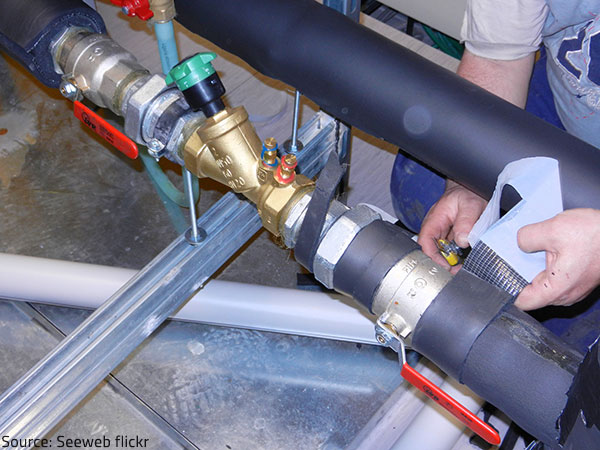
Take adequate measures to keep the pipes warm, regardless of the outside temperatures.
The efficiency of different leak proofing methods depends on several specific factors – climatic conditions in the area, quality of the building materials and the construction work, condition of the existing plumbing system, efficiency of the HVAC system, air tightness of the building, etc. Home waterproofingWaterproofing is the application of materials or coatings de... More, however, is certain to save you from a lot of trouble, whatever the specific circumstances in your case, so it should be among your top priorities.
Get Water Damage Restoration Help
If water still leaks inside despite your efforts, call water damage cleanup and restoration professionals at the first signs of water damage in your home – they will handle the problem in a quick and efficient manner and will give you practical tips on how to best leak proof your house.
You should never hesitate to call a water damage restoration professional, even for minor leaks, because the water will spread and make the damage worse.










